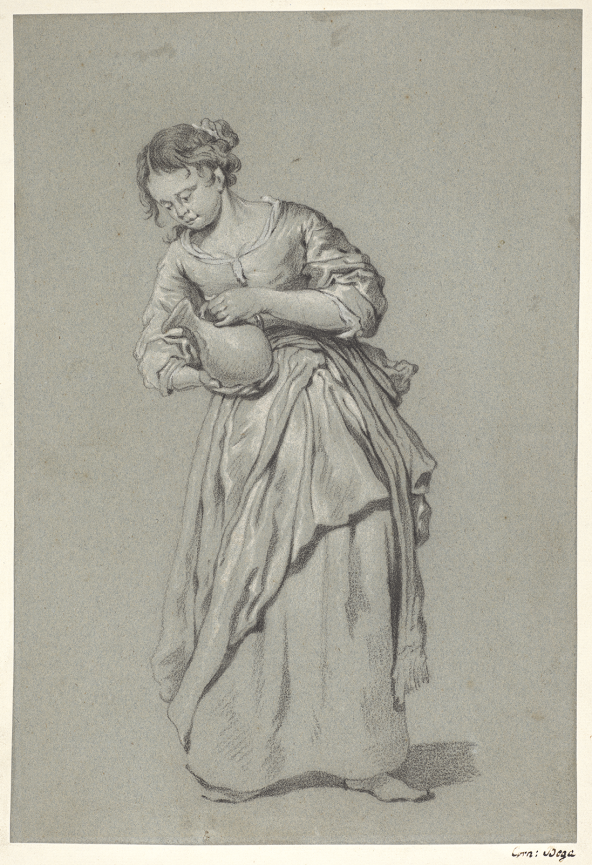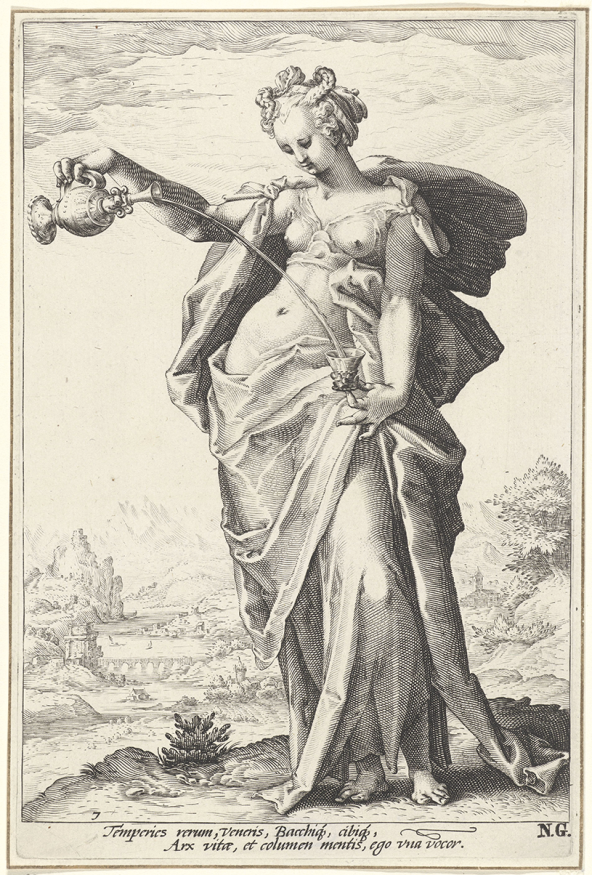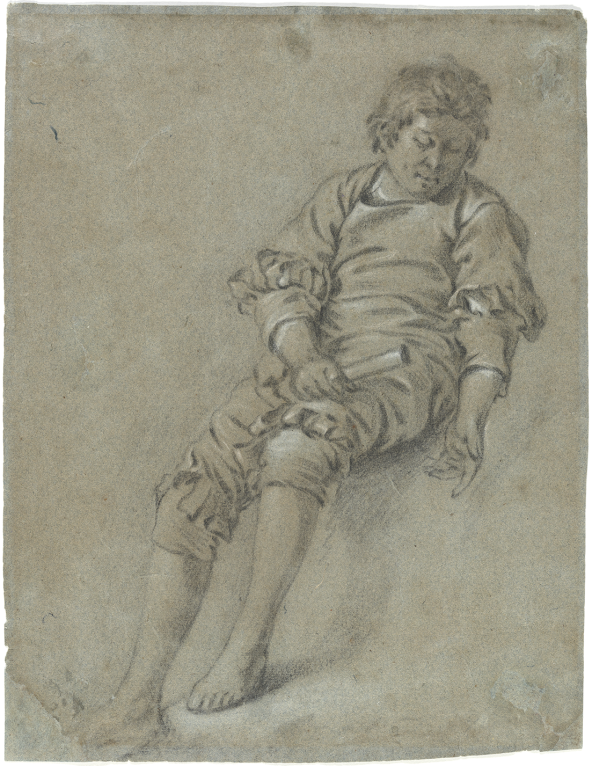Choose a background colour
Jacob Adriaensz Backer, Dutch, 1608-1651: Study of a Man Holding a Glass, c. 1640-50
Black and white chalk on blue paper.
13 3⁄8 × 7 7⁄16 in. (34 × 18.9 cm)
Verso, upper left in pencil, Lely 1618 – 1680⁄15 / No. 160; and lower right, 25.
- Chain Lines:
- Indiscernible.
- Watermark:
- None.
- Provenance:
Sale, Christie’s, Amsterdam, 25 November 1991, lot 67; Sheldon and Leena Peck, Boston (Lugt 3847); gift to the Ackland Art Museum, inv. no. 2017.1.2.
- Literature/Exhibitions:
None.
- Ackland Catalogue:
- 2017.1.2
A man elegantly pours liquid from an imaginary pitcher into a glass and wears the outmoded slashed-sleeve tunic and leggings of a comic figure or tavern regular typically featured in earlier paintings. Jacob Backer likely created the sheet during a communal drawing session organized by his fellow artist colleagues in Amsterdam and would have considered it an exercise rather than a preparatory study for a finished painting. Although not intended for the market initially, the artist’s blue paper figure studies became prized among early drawing collectors for their sensitive handling of black and white chalk.
Jacob Backer’s blue-paper figure studies were as prized by early collectors as they are today. As noted by Arnold Houbraken (1660 – 1719) in his collection of artists’ biographies: “Without doubt he drew his Academy studies, especially of women, so artfully on blue paper with black and white chalk that he took the crown from all his contemporaries. The desire that the connoisseurs of works on paper show when one of his drawings comes up for sale demonstrates the esteem in which they are held.” 1
This previously unpublished drawing can be added to the eighty or so sheets by Backer catalogued by Werner Sumowski in 1979, the majority of which are similar figure studies that likely resulted from academy-like sessions.2
These sessions appear to have been organized by small coteries of artist colleagues in Amsterdam. A frequent participant was Govert Flinck (1615– 1660), whose own notable figure studies on blue paper are sometimes quite close to Backer’s in style, and perhaps reflect their early training together in the Friesland studio of Lambert Jacobsz (1598 – 1636).3
Some of their Amsterdam drawing sessions are significant for producing pioneering and often elegant studies of the female nude (probably the ones Houbraken meant when he referred to Backer’s women), though the majority of this group’s surviving studies depict clothed figures like this one, both male and female.
Backer’s figure here clearly mimics the pouring of a beverage from an imaginary pitcher into a glass depicted in his left hand. The delicacy with which he holds the seemingly weightless pitcher betrays the artificial nature of the pose. For a similar drawing, Backer reversed the props seen here by showing a woman pouring from a jug into a nonexistent receptacle Fig. 21.1.4

Jacob Backer, A Woman with a Jug. Black and white chalk on blue paper, 366 × 252 mm. The Maida and George Abrams Collection, Fogg Art Museum, Harvard University, Cambridge, Massachusetts, Gift of George Abrams in memory of Arthur DuBow, Harvard Class of 1954.
Maida and George Abrams Collection, Boston, Long Term Loan.
Photograph © President and Fellows of Harvard College, 1.2018.205
In his unpublished notes on the Peck drawing, Sumowski remarked that the pose bears a correspondence with the allegorical figure of Temperantia (Moderation).5
She is one of the seven cardinal virtues in classical and medieval iconography, often represented making an adept “long-distance” pour from pitcher to glass. The visual tradition was particularly strong in Renaissance prints, but persisted at least until the time of Hendrick Goltzius (1558 – 1617) Fig. 21.2.6

Jacob Matham (attributed to), after Hendrick Goltzius, Moderation (Temperantia), c. 1587 – 1637. Engraving on paper, 217 × 143 mm. Amsterdam, Rijksmuseum, inv. no. rp-p-ob-27.302.
Rijksmuseum, Amsterdam
Although Backer occasionally created allegories, such as his painted series of the Five Senses that included a drinker with a jug for the sense of Taste, it seems unlikely that he intended any specific allegory for this drawing, especially since the cardinal virtues invariably used female figures. 7
His use of a slashed-sleeve tunic and leggings here is unusual, however. Such outmoded costuming more often denoted comic figures, or those set in low-life tavern scenes by the earlier generation of Caravaggisti. Backer occasionally clothed his figures anachronistically for some of his history scenes and tronies, though such a tunic does not appear in any of his known paintings. He did, however, use the same outfit for another drawing, an unpublished study of a boy also in the Peck Collection that was acquired independently from the present work Fig. 21.3.

Jacob Backer, Study of a Seated Boy, Gazing Downward, c. 1640 – 50. Black and white chalk on blue-gray paper, 293 × 226 mm. Chapel Hill, Ackland Art Museum, inv. no. 2017.1.1.
Sumowski confirmed the attribution of the present drawing to Backer when it first came to light during the 1991 auction from which the Pecks acquired it.8
Stylistically, the softly modeled forms and judiciously placed white highlights link it to a number of Backer’s other similar full-length figure studies of about the same size. It remains difficult to precisely date these drawings, though he probably made most of them in the 1640s.9
Unlike Flinck, Backer was not in the habit of dating his figure studies, and only a few can be related to dated or datable paintings.10
Most of Backer’s figure studies were probably drawn as exercises with no specific painting in mind. They appear to have remained in his possession until his premature death in 1651. Two portfolios containing a total of eighty-four of his drawings appeared in the estate sale of his older brother, Tjerk, in 1659.11
These were part of Jacob’s studio estate and might even comprise most of his surviving drawings today, including those that set off the apparent storm among collectors mentioned by Houbraken.
End Notes
Houbraken 1718 – 21, vol. 1, 338: “Zeker hy heeft zyne Academie-beelden, inzonderheid de vrouwtjes zoo konstig op blaau papier met swart en wit kryt geteekent, dat hy daar door de kroon van alle zyne tydgenooten heeft weg gedragen. ‘t Is ook haast aan de zugt der papierkonstminnaars, wanneer ‘er van zyne teekeningen op een verkooping komen, te zien wat agting zy voor dezelve hebben. ”
For Backer’s early training and biography, see J. van der Veen in Amsterdam & Aachen 2008 – 09, 11 – 25. For Backer’s figure studies and these academy-like sessions generally, see P. Schatborn in Amsterdam & Washington 1981 – 82, 88 – 89, 90 – 91; W. W. Robinson in London, Paris & Cambridge 2002 – 03, 124 – 25, under no. 49; P. van den Brink in Amsterdam & Aachen 2008 – 09, 76 – 82; J. Noorman in Amsterdam 2016, 11 – 43; and W. W. Robinson in Washington & Paris 2016 – 17, 178 – 81, under no. 70. For attribution issues that have arisen in distinguishing Backer’s and Flinck’s drawings, see P. Schatborn in Amsterdam 2014, 77 – 80, nos. 21 – 22.
W. W. Robinson in Amsterdam, Vienna, New York & Cambridge 1991 – 92, 120 – 21, no. 50.
The drawing is also slated to appear in a forthcoming addenda volume for Sumowski’s Drawings of the Rembrandt School, based on his manuscript housed in the Museum het Rembrandthuis, as no. 2855. With thanks to David de Witt for supplying this information.
New Hollstein (Jacob Matham), vol. 3, no. 327.
For Backer’s Allegory of Taste (Berlin, Gemäldegalerie, inv. no. 935A), see D. Hirschfelder in Amsterdam & Aachen 2008 – 09, 104 – 07, no. 9B.
As noted in the catalogue entry for the sale (Christie’s, Amsterdam, 25 November 1991, lot 67).
In his notes on this drawing (see note 5, above), Sumowski assigned a date of circa 1650, but the softer contrasts and modeling in this work actually relate it more closely to drawings he assigns to circa 1640 – 45.
See Sumowski Drawings, vol. 1 (1979), 15. Long ago, Kurt Bauch surmised that the structure and tonality of Backer’s figure studies gradually became finer, but it has not proven possible to confirm such a hypothesis; see Bauch 1926, 24 – 27.
Bredius 1915 – 22, vol. 4, 1241 – 42; and J. van der Veen in Amsterdam & Aachen 2008 – 09, 25.
